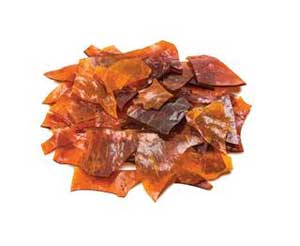
What’s the best way to apply shellac, and should you buy premixed or mix your own?
Michael Dresdner: The ‘best’ way is whatever works best for you. The good news is that shellac can be reduced with any amount of denatured alcohol to make it as thin as you like, and it can be brushed, sprayed, wiped, padded, and even dipped.
I always start with a sealer coat of 2 lb. cut dewaxed shellac applied by rag. I don a pair of thin gloves, dip a rag, sponge or Scotchbrite? pad into the shellac, flood it onto the wood, then wipe it off while it is still wet. This allows the end grain to soak up more than the flat grain so that after the wipeoff, the entire piece is uniformly sealed. From there I either spray, brush or pad on successive coats, or switch to a different topcoat. As long as it is dewaxed, you can use shellac under virtually any other finish. (Some finishes won’t stick to the wax in natural shellac.) If you are applying shellac exclusively, I find that wax-free shellac handles better, dries faster, and is clearer than that with the wax still in. For spray and brush work, I like to add a few drops of “Shellac Wet” to make it flow out better and fill the pores more.
As of this writing, all the pre-mixed shellac in cans contain wax, with the exception of spray cans. Those are dewaxed because the wax clogs the spray tips. That means if you want to try dewaxed shellac, you will have to buy flakes and mix it yourself. That is about to change. The Zinsser company, which is the largest shellac seller here in the US, is about to introduce a ‘Universal Sealer’ which is nothing more than dewaxed shellac in a 2 lb. cut. It should be out early in 2001. The good news is that I’ve tried the test batch, and it is wonderful. The better news is that it is made with a new patent pending process that will give it a far longer shelf life than what you could mix on your own ? at least three years and possibly longer.
Ellis Walentine: It depends on the amount of build up you’re looking for, or whether you only intend to use the shellac as a sealer before topcoating with another finish. If you want to build a shellac finish, use heavier cuts – 3 lb. is about right – and brush it on with a badger or china bristle brush. Sand lightly between coats. For thinner coats – in the 1-2 lb. range – you can use a brush or a rag to apply the shellac.
Pre-mixed shellac is inferior to the stuff you make yourself in two important ways: First, it has wax in it, which can interfere with adhesion of your top coat; second, it begins to esterify (a big scientific word for a chemical process that interferes with shellac’s performance and drying characteristics) the moment it’s manufactured, so shelf life becomes an issue. Old shellac just plain won’t dry.
I like to keep a couple jars of homemade shellac – usually super blond, orange and/or garnet ? around at all times, plus a pot of alcohol to keep my brush limber between uses.





